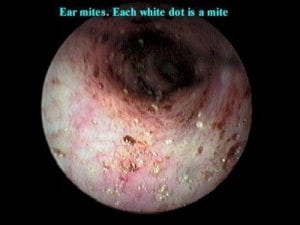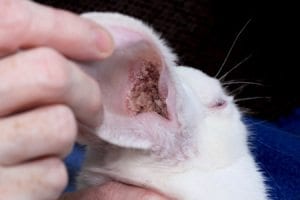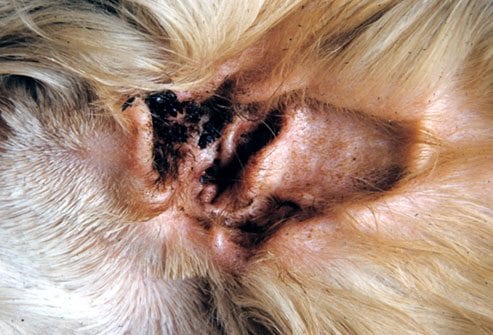By Dr. Liza Curman
Our first stop on the mite train is Ear mites: Part 3
Ear mites are small, whitish-grey in colour and are visible to the human eye. We use a piece of equipment called an Otoscope to visualise them in your pet’s ear canal. They move away from its light. However, there can be huge numbers (over 1,000) deep in the ear canal, and you won’t be able to see a single mite at the entrance of the ear canal.

Looking down the vets otoscope into the ear canal
Ear mites feed on the wax and dead skin cells shed by our pets’ ears. They like dark, waxy, moist conditions and that is why the ear canal suits them. They are spread by direct contact between our pets, and also on the coats of infected pets e.g on the paw of the leg used to scratch the very itchy infected ear. They can survive on bedding and soft furnishings for short periods of time.
What do we need to watch out for in our pets:
- Head shaking
- Thick, dark, black/brown wax
- Excessive scratching of the ears
- Red & inflamed under sides of their ears
- In severe cases dogs can shake their heads so much that they burst a blood vessel on the surface of the ear and a haematoma can develop, which often will require surgery to resolve.

Black waxy discharge associated with ear mites
How can we treat our pets:
First they need to be seen by a vet and a suitable medicated product used. Now not all products are created equally, as some over-the-counter products claim to kill mites through “drowning”, but this is just not an effective method. Only prescription medication contains the active ingredient that can kill these mites effectively and these are only available from your vet.
Washing their bedding in a boil wash and vacuuming the affected areas will also help reduce re-infection.
However, as with most things, prevention is better than cure – keeping your pets’ ears clean and dry is very effective. Don’t over clean as this will encourage more wax production but monitor your pets’ ears and clean with cool boiled water and cotton wool if you find your pet has ‘waxy ears’ then call in to Clare Street Vets or Shannon Vets for a veterinary ear wash. Dry your pets’ ears well after bath time or swimming. And in dogs whose ears flop down, tie them up, especially in the summer months, this allows them to dry out and air to circulate. This is very well tolerated if a dog is trained from a young age. Plucking the hair from your dog’s ear canals will also help, again to allow air to circulate and create a dry environment which mites don’t like.
Rabbits also suffer with ear mites, they can develop severe crusting lesions on their pinna. Don’t be tempted to pull these lesions off. Softening them first with mineral oil will help ease them off, but treatment with an effective mite product is vital. Call in and talk to us, we are all ears!

Crusting lesions in the rabbit


